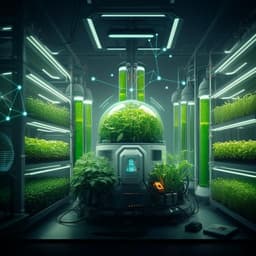
Engineering and Technology
Ammonia marine engine design for enhanced efficiency and reduced greenhouse gas emissions
X. Zhou, T. Li, et al.
This groundbreaking study by Xinyi Zhou, Tie Li, Run Chen, Yijie Wei, Xinran Wang, Ning Wang, Shiyan Li, Min Kuang, and Wenming Yang unveils an innovative in-cylinder reforming gas recirculation (IRGR) method to significantly boost thermal efficiency and cut emissions in ammonia combustion engines. Experience a remarkable 15.8% increase in efficiency and up to 94% reduction in greenhouse gases compared to traditional diesel engines!
~3 min • Beginner • English
Introduction
The maritime sector targets steep greenhouse gas (GHG) reductions (IMO: −70% by 2040, net-zero around 2050). Ammonia is a promising carbon-free marine fuel due to established infrastructure, storage advantages, and absence of CO2 and carbonaceous engine-out emissions. However, ammonia’s poor combustion properties (high ignition energy, narrow flammability, slow flame speed) lead to high unburned NH3 and N2O, and efficiency penalties in pilot-diesel-ignition dual-fuel engines. Conventional optimization strategies (split or very-early diesel injection) face trade-offs, often increasing NOx or N2O. The study proposes in-cylinder reforming gas recirculation (IRGR): one cylinder runs fuel-rich to partially decompose excess NH3 to H2; its exhaust (H2-enriched, with typical EGR constituents) is routed to the other cylinders. The hypothesis is that combining hydrogen-enriched combustion with EGR-like dilution will improve thermal efficiency while simultaneously reducing unburned NH3, NOx, N2O, and overall GHG emissions.
Literature Review
The paper reviews alternative marine fuels (hydrogen, ammonia, methanol, methane), highlighting ammonia as a balanced carbon-free option with existing infrastructure and lower lifecycle cost prospects. It contrasts high-pressure dual-fuel (HPDF) and low-pressure dual-fuel (LPDF) ammonia-diesel modes. HPDF can mitigate clearance-volume slip but shows high unburned NH3 (e.g., 6800–9300 ppm) and system complexity/corrosion challenges. LPDF requires fewer engine modifications and can have better fuel economy but suffers from high unburned NH3 and N2O (e.g., 4000–14,500 ppm NH3 as AER increases; N2O up to ~1.75 g/kWh). Conventional strategies such as split and very early diesel injection can reduce unburned NH3 but often raise NOx and/or N2O, reinforcing trade-offs. Prior "dedicated EGR" concepts in SI gasoline engines showed hydrogen produced via reforming or partial oxidation improves EGR tolerance and efficiency. The present IRGR concept differs in intake system independence of the reforming cylinder, lack of external catalysts, diesel-piloted ammonia combustion mode, and carbon-free fuel focus, with no prior verification on ammonia-fueled engines.
Methodology
The study combines experiments and 3D-CFD simulations. Experimental setup: a four-cylinder ammonia–diesel dual-fuel base engine (95 mm bore × 102 mm stroke, compression ratio ~17.5, eight-hole 0.127 mm nozzle) without IRGR provided validation data. Operating conditions included 1000 rpm, 75% load (BMEP ~0.7 MPa), diesel injection pressure 120 MPa, intake temperature 318 K, ammonia supply pressure 0.6 MPa, and ammonia energetic ratios (AER) of 40%, 60%, 80%, 90%. Measurements used HORIBA analyzers (NOx, CO2), FTIR (NH3, N2O), AVL pressure transducers, and dynamometer control.
Numerical modeling: Simulations used CONVERGE with SAGE combustion solver, RANS with RNG k–ε turbulence and Han–Reitz heat transfer models. Diesel injection and spray were modeled with Lagrangian particles, KH–RT breakup, dynamic drag, no-time-counter droplet collision, and Frössling evaporation. A merged and updated ammonia/n-heptane kinetic mechanism (65 species, 344 reactions) was developed (Mechanism No. 7), updating rate constants for NH3+OH↔NH2+H2O, NH2+NO2↔H2NO+NO, and NH2+NO2↔N2O+H2O based on recent literature. The model window covered from intake valve closure to exhaust valve opening. Grid: base 1.8 mm with mesh refinement near nozzles and adaptive refinement.
Model validation: The mechanism and CFD setup were validated against experimental in-cylinder pressure and apparent heat release under AER 40–90% and loads 50–100%. Mechanism No. 7 reproduced ignition delay, combustion phasing, pressure, and emissions (NH3, NO, N2O, GHG) with low error (e.g., NH3 prediction errors 7.8%, 5.6%, 3.5%, 0.9% at AER 40%, 60%, 80%, 90%).
IRGR configuration and operating matrix: A four-cylinder IRGR concept was simulated where Cylinder #1 is a dedicated reforming cylinder operating rich (overall excess air ratio λ of 0.7 or 0.8), partially decomposing NH3 to H2; its exhaust (containing H2, NH3, CO, O2, N2, CO2, CH4, NO, NO2, N2O, H2O) is recirculated to Cylinders #2–4, achieving hydrogen enrichment plus EGR-like dilution. Studies varied diesel energetic ratio (DER 3%, 10%, 20%), injection timing (−20 to 0 °CA aTDC), engine speed (1000, 1500, 2000, 2500 rpm), and Cylinder #1 enrichment (λ=0.7, 0.8). For fair comparison, total input energy per cylinder was held at 1717 J for the base engine and Cylinders #2–4; Cylinder #1 input was ~1988 J, accounting for recirculated unburned energy being credited to #2–4. Cylinder #1 diesel injection timing was fixed at −6 °CA aTDC (not optimized) to control computational cost. The base engine overall excess air ratio was ~1.5, reduced to ~1.1 for Cylinders #2–4 due to IRGR.
Key Findings
- Dedicated reforming cylinder behavior: At λ=0.7, 0.8, 0.9 and 1000 rpm, 10% DER, −6 °CA aTDC injection, intake 318 K: hydrogen conversion ratios (H2 energy / input NH3 energy) were ~32.0% (λ=0.7), 20.8% (λ=0.8), and 8.8% (λ=0.9). Hydrogen forms near high-temperature regions via NH3 reforming/decomposition. Due to low O2, NO and N2O formation in the reforming cylinder are small.
- Combustion in hydrogen-enriched cylinders (#2–4): Hydrogen addition reduced quenching distance and eliminated most clearance-volume NH3, while EGR constituents (CO2, N2) moderated temperatures. Compared to base, IRGR reduced unburned NH3 and NOx and shortened combustion duration slightly at higher H2 enrichment.
- At 1000 rpm, 10% DER, −6 °CA aTDC: IRGR reduced unburned NH3 by ~84% and decreased NOx and N2O; unburned losses fell from 11.6% to ~3.0%, improving heat balance albeit with higher cooling losses due to improved combustion.
- Across AER 80–97% and injection timings (−20 to 0 °CA aTDC): IRGR generally reduced NOx (extending timing window within IMO Tier II limits), increased indicated thermal efficiency (ITE), and sharply reduced NH3 and N2O. At AER 97%, the base engine’s NH3 exceeded 72 g/kWh and ITE <40%, whereas IRGR cut NH3 to ~8 g/kWh and raised ITE to ~46%.
- Best points within IMO Tier II NOx limit (varying AER 80–97% and Cylinder #1 λ=0.7–0.8): IRGR increased ITE by at least 10.9% and reduced unburned NH3 and N2O by at least 85.0% and 82.1%, respectively. Higher reforming enrichment (λ=0.7) provided greater NH3 and N2O reduction by boosting in-cylinder temperature and N2O thermal decomposition.
- Specific headline results: At 3% DER and 1000 rpm, IRGR increased ITE by 15.8% and reduced unburned NH3 by 89.3%, N2O by 91.2% versus the base ammonia engine; relative to pure diesel mode, carbon footprint was reduced by 97.0% and GHG by 94.0%. At 20% DER and 2500 rpm, IRGR increased ITE by 24.4% and reduced NH3 by 86.6% and N2O by 83.7% versus base.
- High-speed operation (1500–2500 rpm, AER 80%): Base engine performance degrades with speed (higher NH3, N2O; lower ITE). IRGR remains effective; at 2500 rpm it improved ITE by 24.4% and cut NH3 by 86.6% and N2O by 83.7% at best points within NOx limits.
- GHG impact (computed as CO2 + 298×N2O): Despite high ammonia share, base ammonia engines may miss IMO targets due to N2O. IRGR substantially lowers N2O and improves ITE, delivering up to 83.7% GHG reduction versus base ammonia engine and 94.0% versus pure diesel at 3% DER.
Discussion
The IRGR concept directly addresses ammonia engine bottlenecks by merging hydrogen-enriched combustion with EGR-like dilution via an in-cylinder reforming approach. Hydrogen enrichment accelerates ammonia oxidation, reduces quenching, and minimizes clearance-volume fuel slip, cutting unburned NH3. Simultaneously, EGR species reduce oxygen availability and peak temperatures, suppressing thermal NOx and curbing N2O formation; higher hydrogen levels further promote N2O thermal decomposition. This dual action breaks the traditional trade-off between unburned NH3 and NOx seen with split or very-early pilot strategies. The validated 3D-CFD framework and updated kinetic mechanism support the robustness of the predicted benefits across wide operating ranges (AER 80–97%, multiple speeds up to 2500 rpm). The results imply IRGR can expand feasible injection timing windows within IMO Tier II NOx limits, enhance efficiency via reduced unburned loss, and deliver substantial lifecycle GHG benefits by limiting N2O despite high ammonia utilization. Compared to external reformers or catalyst-dependent dedicated-EGR systems, IRGR avoids extra heat-transfer penalties, catalyst costs, and added complexity while being tailored to diesel-piloted ammonia combustion.
Conclusion
The study introduces and evaluates in-cylinder reforming gas recirculation (IRGR) for pilot-diesel-ignition ammonia engines. A new ammonia/n-heptane kinetic mechanism (65 species, 344 reactions) was developed and validated experimentally. Simulations show that operating one dedicated cylinder rich to reform NH3 into H2 and routing its exhaust to the other cylinders can simultaneously: (1) elevate indicated thermal efficiency by 10.9–24.4% across conditions, (2) reduce unburned NH3 by ≥85% and N2O by ≥82%, and (3) cut GHG emissions drastically (up to 83.7% vs base ammonia engine and 94.0% vs pure diesel). At 3% DER and 1000 rpm, IRGR raised ITE by 15.8% and cut NH3, N2O by 89.3%, 91.2% versus base; at 2500 rpm and 20% DER, ITE gain reached 24.4% with large NH3/N2O reductions. The concept mitigates the NH3–NOx trade-off and maintains performance at higher speeds and high ammonia shares, supporting maritime decarbonization targets. Future work should experimentally realize IRGR hardware, optimize control (including reforming-cylinder injection timing and load balancing), address backfire risks, refine EGR/hydrogen distribution and turbocharging integration, and assess durability and ship-scale implementation.
Limitations
- The IRGR assessment is primarily based on detailed 3D-CFD simulations; no full experimental validation of the complete IRGR system is reported.
- The dedicated reforming cylinder’s pilot-diesel injection timing was fixed (−6 °CA aTDC) and not co-optimized with the hydrogen-enriched cylinders to limit computational cost; further optimization could change outcomes.
- Cylinder #1 received higher input energy (~1988 J) than Cylinders #2–4 (1717 J), creating slight IMEP imbalance; practical implementations would need active balancing strategies.
- Risk of backfire in hydrogen-enriched operation is noted and would require design countermeasures.
- Results were validated on a specific engine platform and operating range; generalization to other engine architectures and real-ship conditions requires further study.
Related Publications
Explore these studies to deepen your understanding of the subject.







